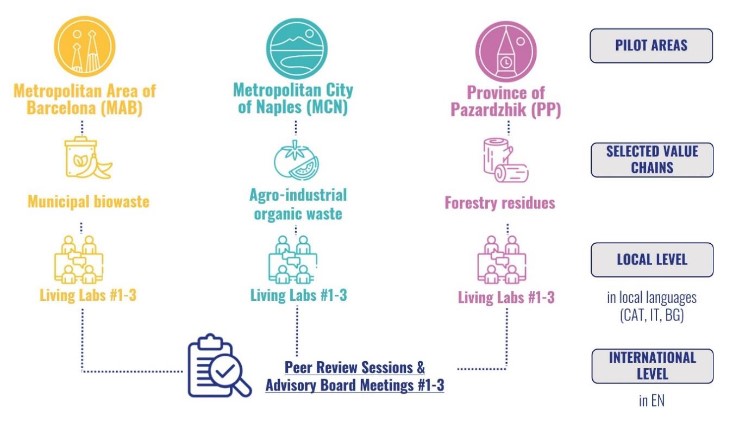
After a first situational analysis, partners identified and analysed circular bioeconomy best practices that could be successfully implemented in the pilot areas, mapping opportunities and obstacles to the introduction of such processes.
Best practices and case studies of circular bioeconomy at local level and across Europe
Best practices and case studies of circular bioeconomy have been identified to look for examples of methods of dealing with known process bottlenecks and collect examples of successful national/regional policy instruments.
- Policy framework: partners analysed 122 documents about circular bioeconomy published between 1986 and 2022 and linked to the three pilot areas at local, regional, national, and European level to draw a picture of the policy framework on circular bioeconomy and biowaste management.In general, most of the documents analysed have been published at national level. The local administrations are producing less documents, as it can be expected that they adapt the upper existing regulations. Regarding the difference in number of documents published between the pilot territories, Catalonia is the most active of the three regions studied with more documents promoting regulation and plans regarding environment and particularly waste management than the others. The Bulgarian circular bioeconomy policy framework can be considered younger than that of the other pilot areas, explaining why less documents have been produced.Main conclusions of this analysis are shared in the Policy framework on circular bioeconomy and biowaste management report.
- Good practices: they also gathered 36 Good Practices complemented by a selection of additional practices and a selection of actions promoting knowledge on circular bioeconomy.Most of the Good Practices collected aim to improve the quality and the quantity of collected biowaste through various tools such as technological innovation, including identification systems and access control. Separate collection of biowaste is still a major concern in biowaste management as it affects recycling possibilities. Even though separate collection of biowaste and other wastes has been implemented in most of EU countries, the quantities collected and the quality of biowaste still need to be improved to optimise its recovery and increase the quality of the outputs.This work is presented in 36 Good Practices and more on circular bioeconomy and biowaste management.
Validation and support of project choices and preliminary results
At each stage of the work, from the selection of the biowaste chain to the development and validation of alternative scenarios, the local stakeholders of the three pilot areas and external experts have been involved to generate a collaborative knowledge and ensure that the project is going in the right direction. This happened through:

Regulatory frameworks for implementing circular bioeconomy at local level
Partners analysed regulatory frameworks for implementing circular bioeconomy at local level, with a particular focus on the requirements of end-of-waste for organic residual streams.
Impact of alternative scenarios
Partners explored, according to a Life Cycle Thinking approach, the environmental and economic sustainability of the biowaste systems selected by the project and compared them with alternative scenarios, in each pilot area. These assessments allowed to develop recommendations for enhancing organic waste (biowaste) prevention, valorisation, and management optimisation.
The analyses show that, for all the pilots, the Alternative scenarios are a more sustainable option thanks to the production of sustainable bio–based products that can replace their fossil counterparts. In addition, the most impacting processes from an environmental point of view are electricity consumption and transport. These results are useful for local stakeholders and policymakers to understand the importance of focusing on: (i) energy efficiency strategies and (ii) valorisation at territorial level to support the local economy and reduce transport.